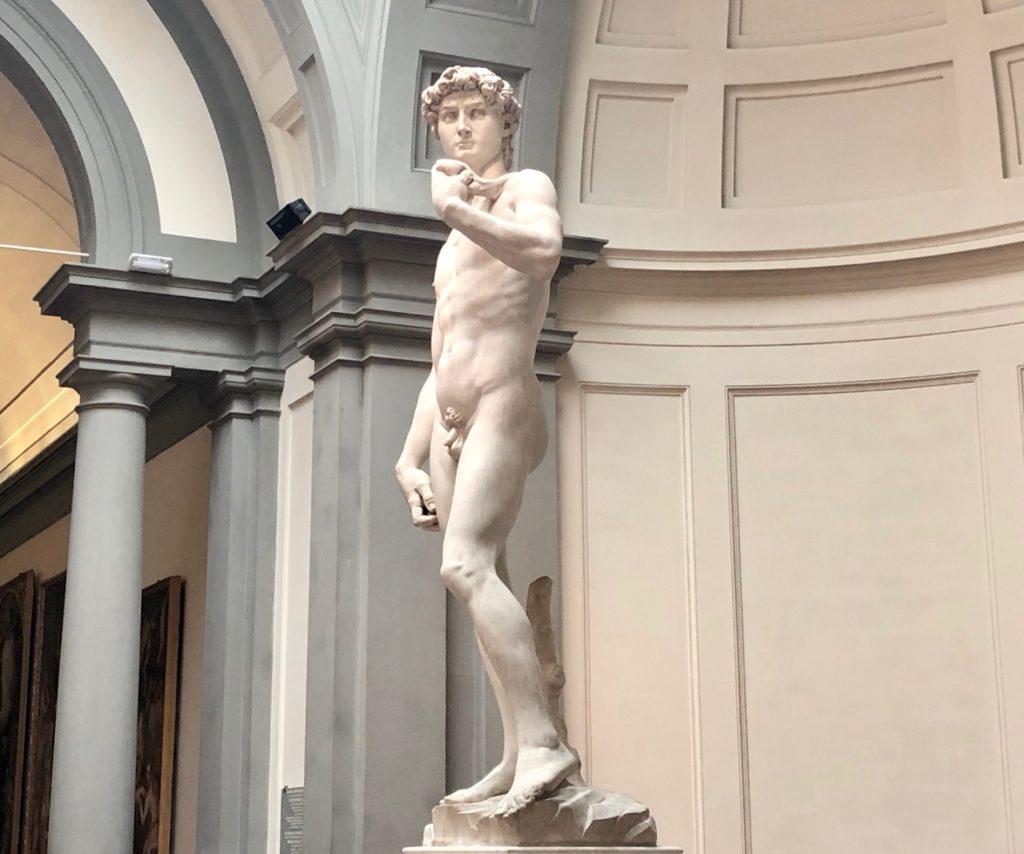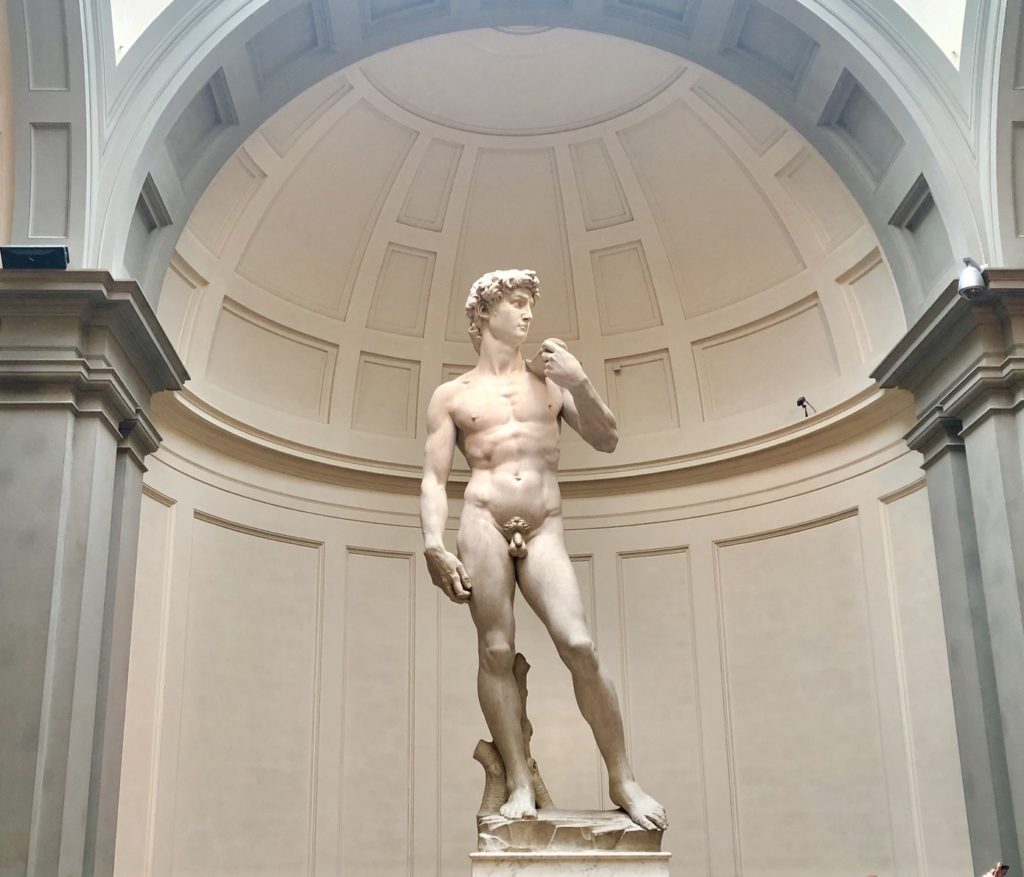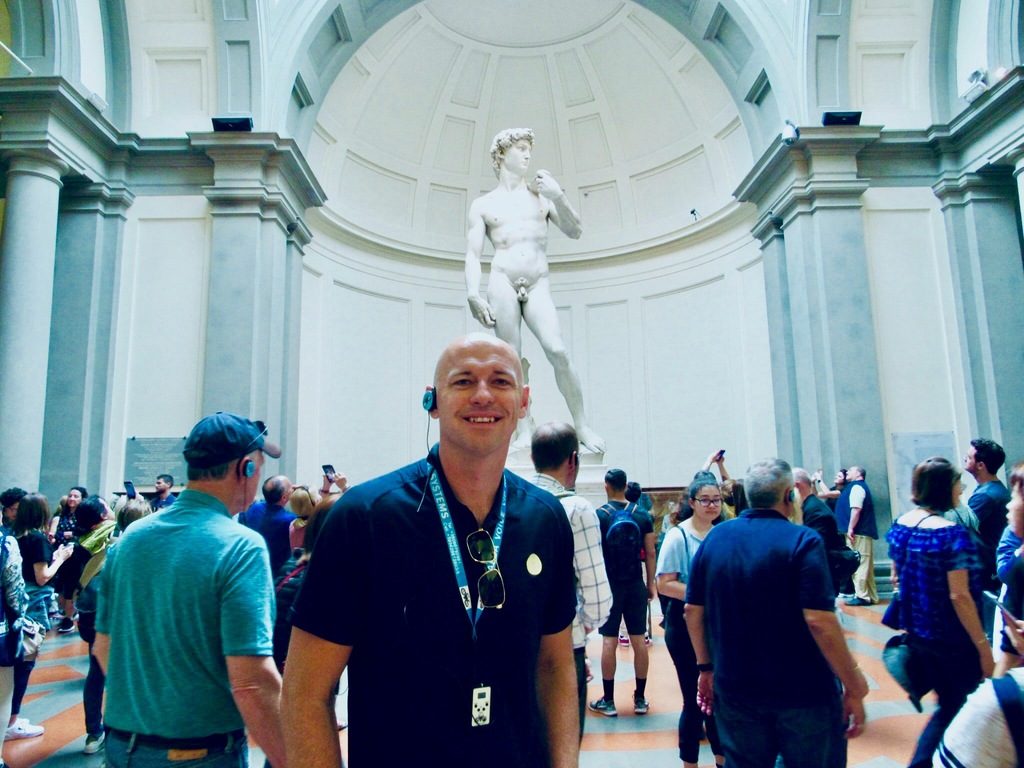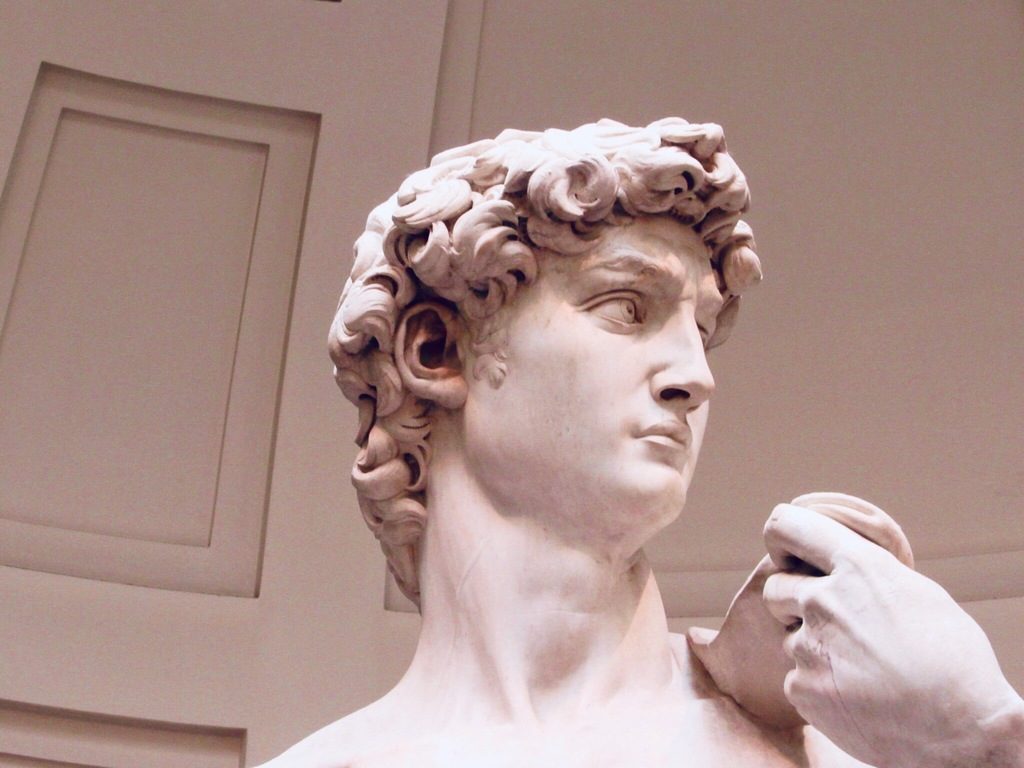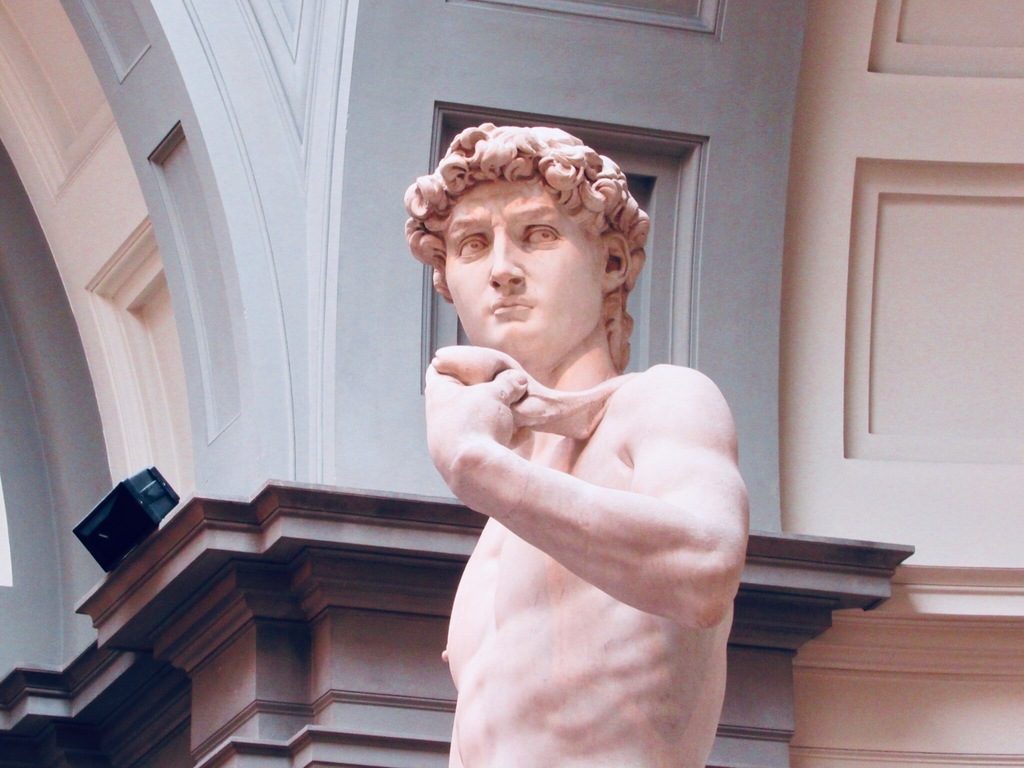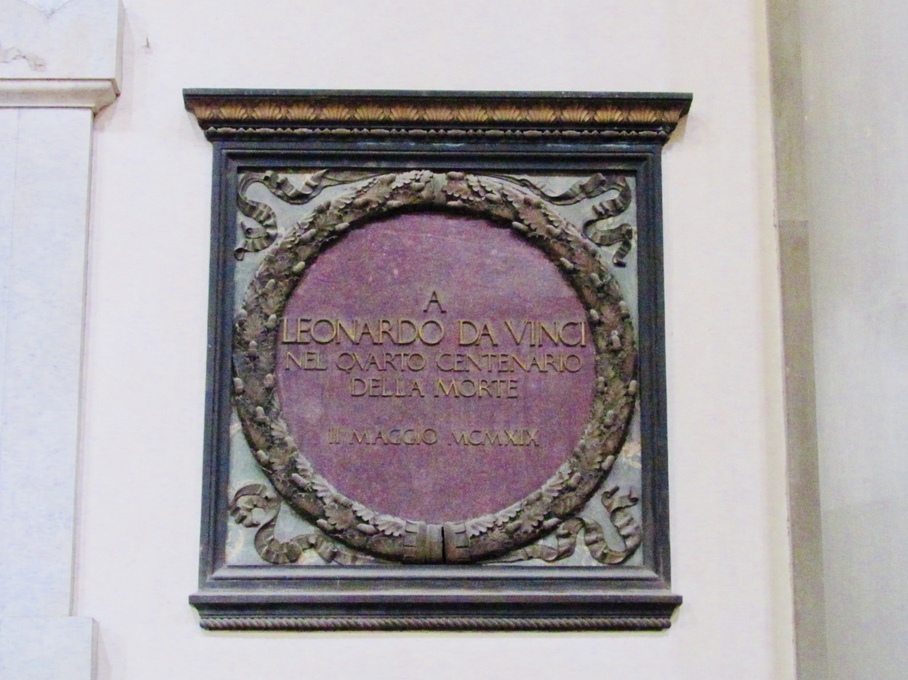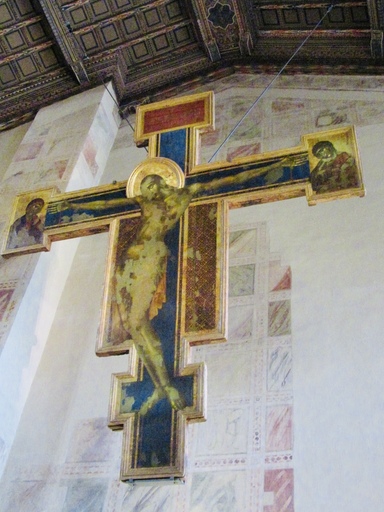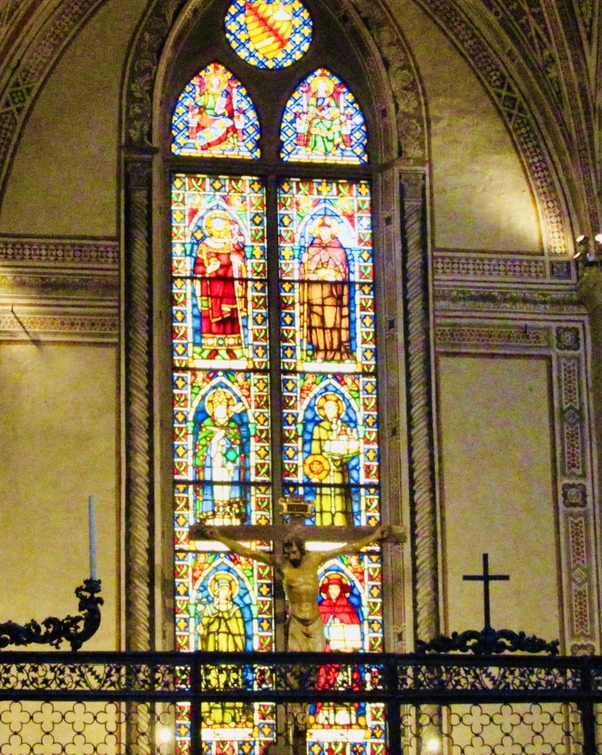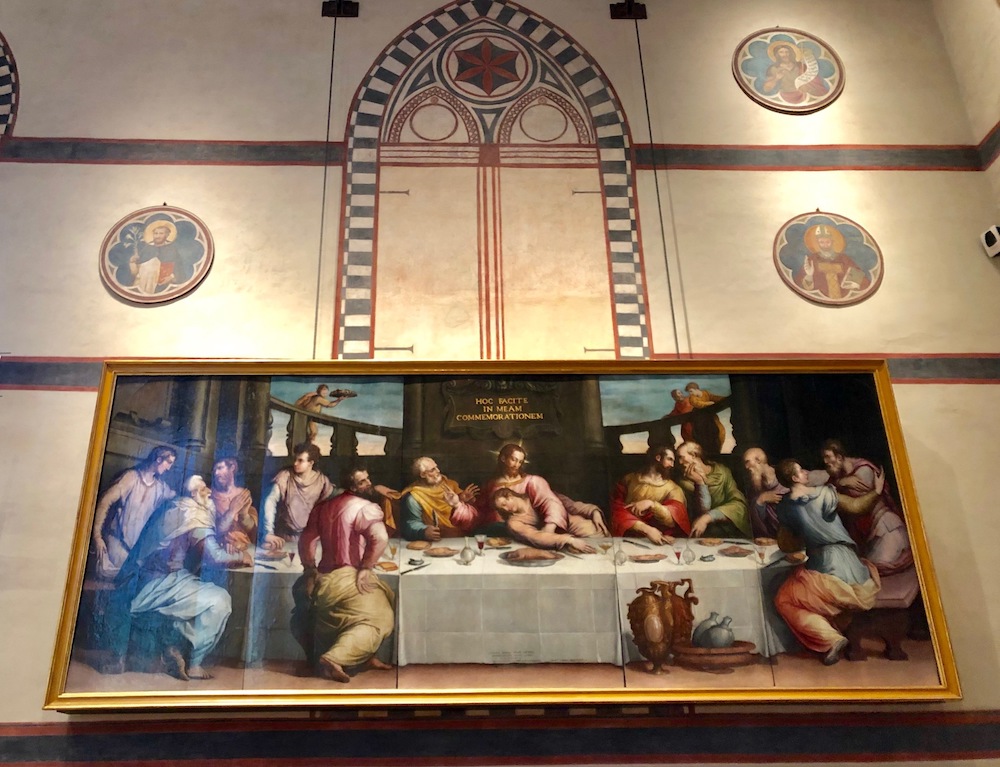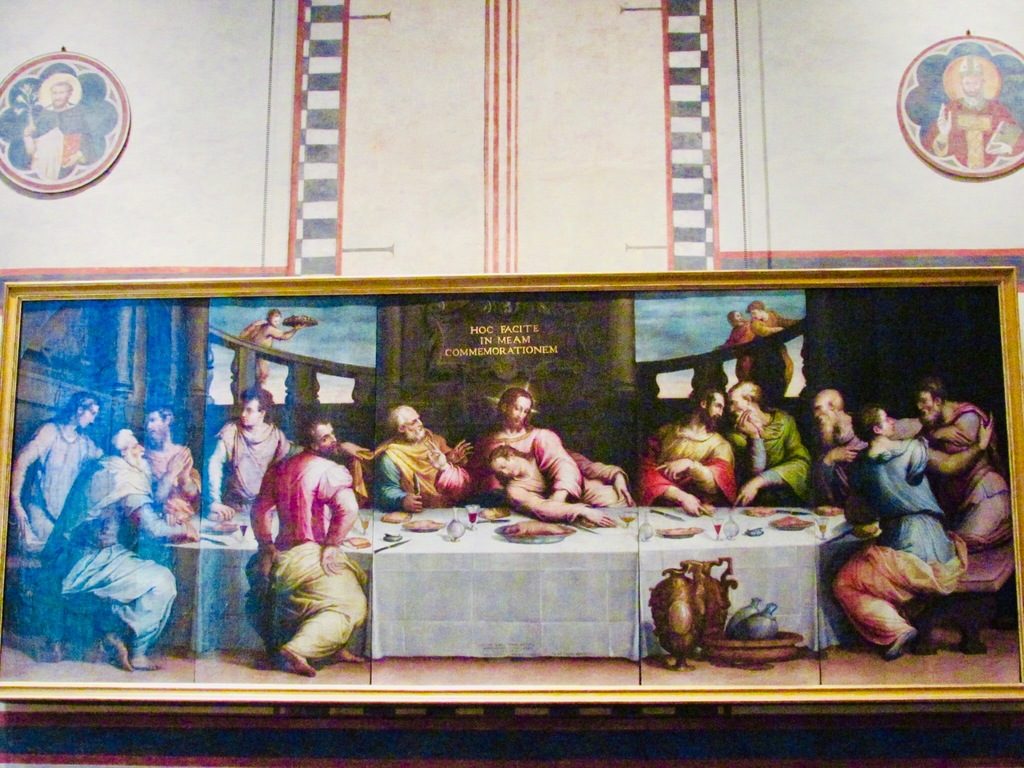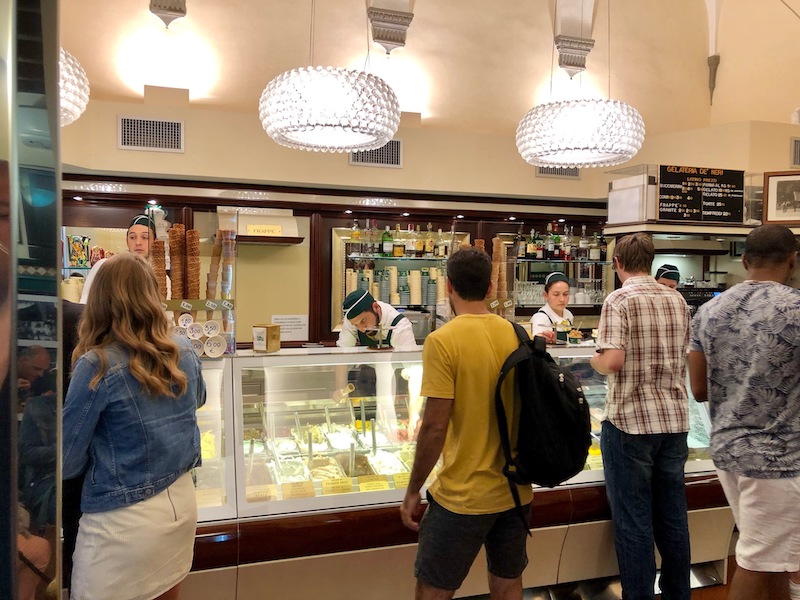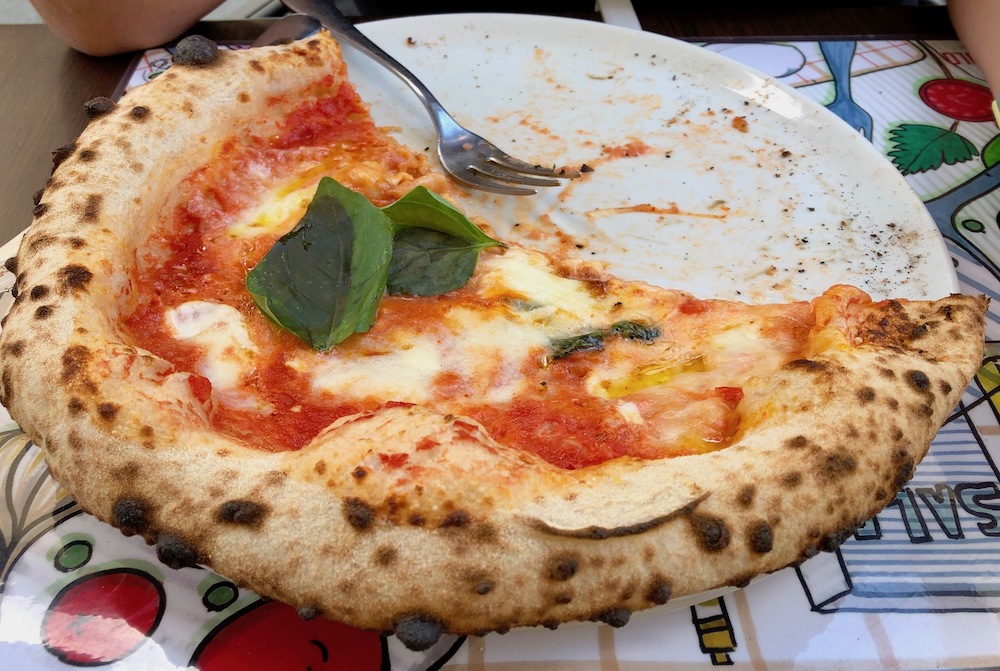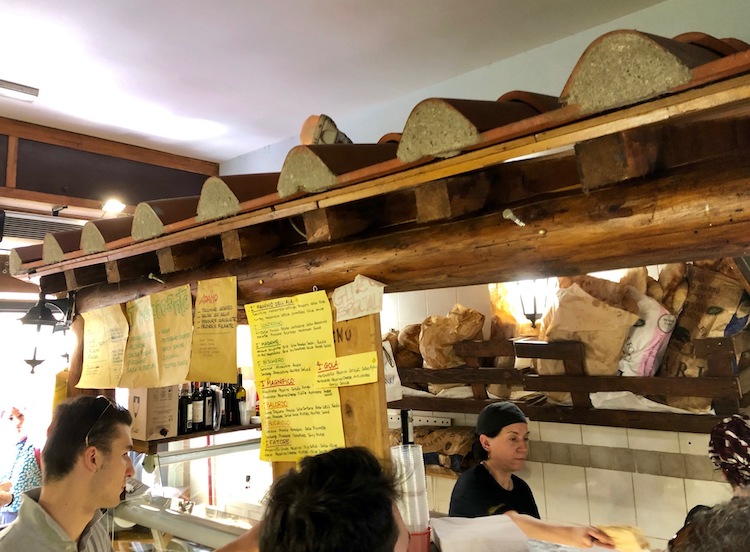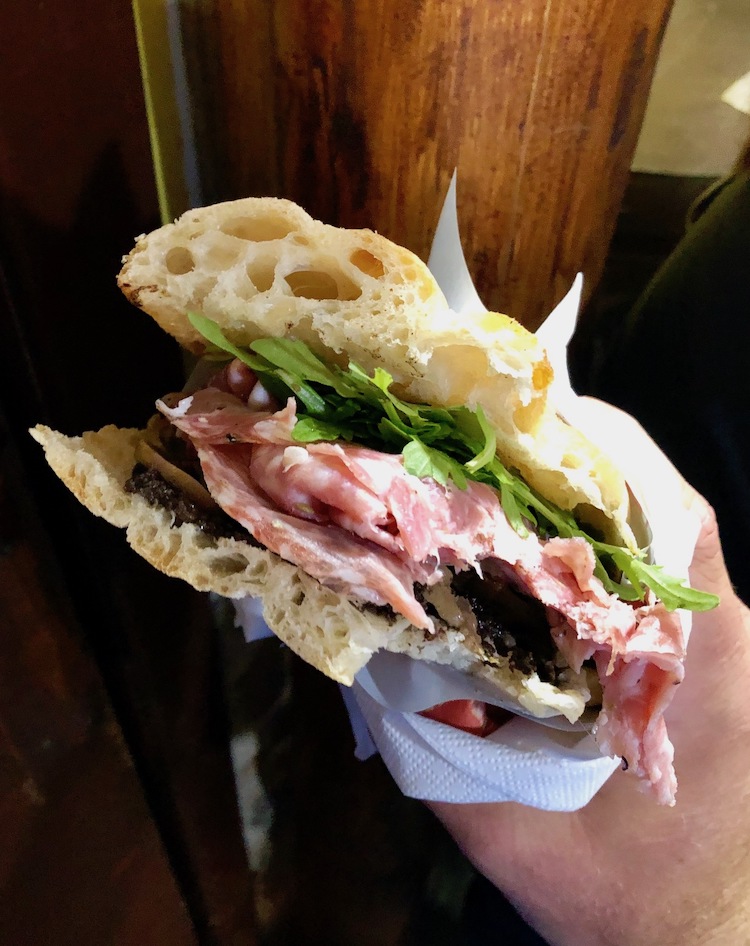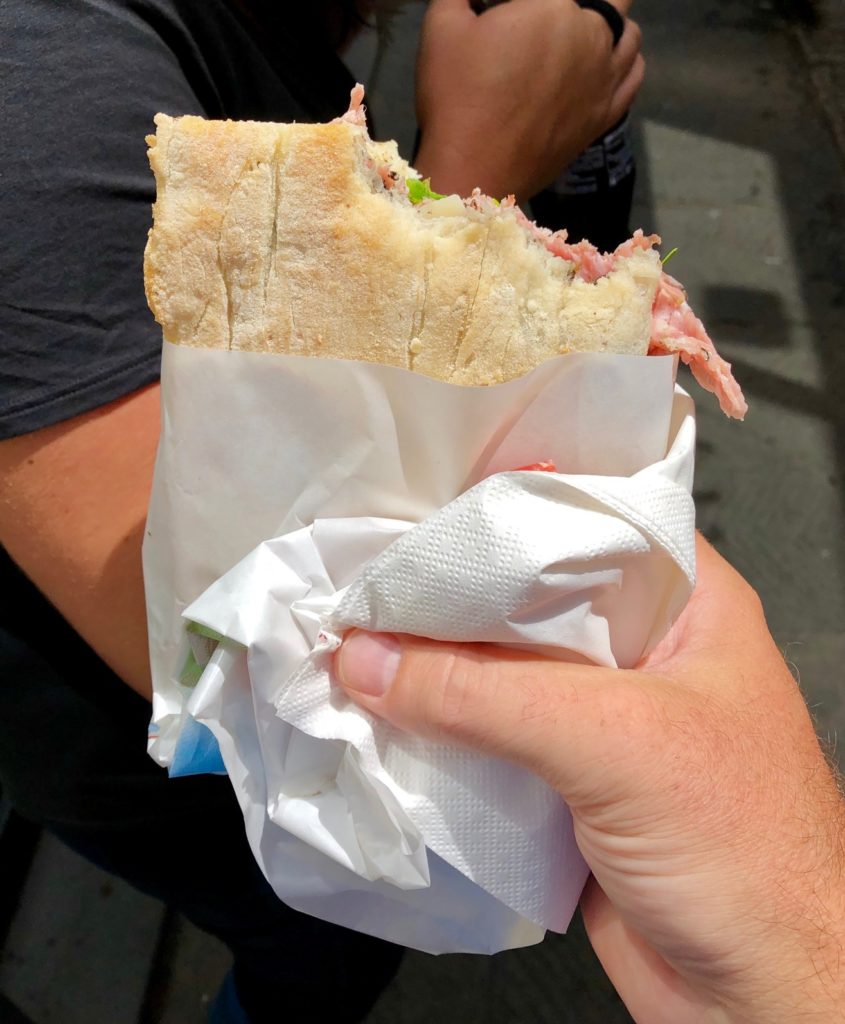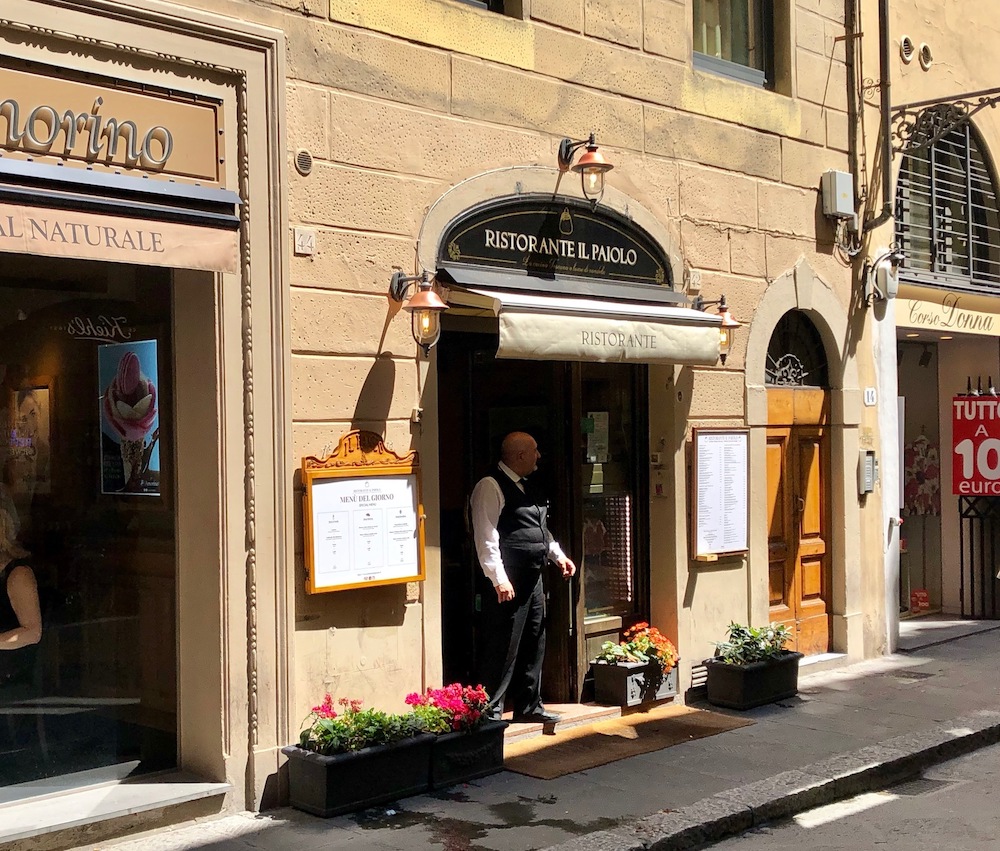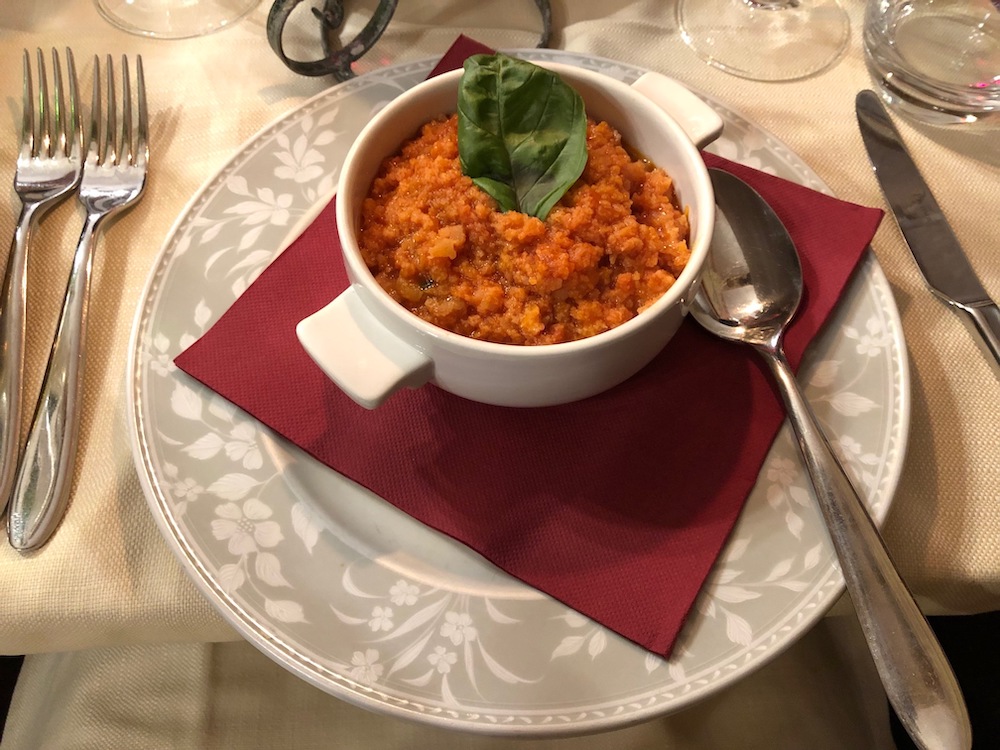Florence or “Firenze” as its known in Italy is the capital of Tuscany. The mere mention of the word “Tuscany”, for many, will surely conjure up visions of lush hillsides, wines, cheeses, or worse, cheesy movie memories of Diane Lane in “Under the Tuscan Sun”. There is an inherent whimsy that is associated with the Italian way of life, especially in Florence. It encapsulates both past and present. In Firenze, you can stand in buildings built in the 1200’s, cross bridges built in the 1300’s, and roam the same streets that Michelangelo, Donatello, Leonardo da’Vinci, Machiavelli, Galileo, and the Medici’s once did.
The city of Florence does have a certain buzz and flow about it. JJ kept mentioning this feeling. That although there were people everywhere and the sidewalks and streets were uber-crowded, that it wasn’t crowded in a bad or mad sort of way. Rather, maybe the descriptor I’m looking for is that Florence is a happy place. I wouldn’t normally describe a very large city that way. I’ve tried to make it clear on this Blog that JJ and I prefer the quieter, more remote, and lesser known locales (like Annecy or Menton, France). Maybe it’s the fact that visitors are seeing some of the most world renowned art and architecture, while eating some of the best and most authentic Italian food of their lives. Whatever it is, JJ had been telling me for months that Florence was one of the best places she had visited in those formative teenage travel years with her grandparents, and as things rarely do, Florence was living up to the hype.
We don’t want to be pretentious enough to say something as trite as “there’s those who have been to Florence, and those who haven’t”, but there may be some truth to such a statement. Perhaps it can be better stated as “there are those who have seen the Statue of David, Michelangelo’s tomb, or the Last Supper, and those who haven’t”. There, that sounds more inspirational, doesn’t it?

I think JJ would agree that the Galleria di Academia and the Santa Croce are right up there with the Louvre in Paris on places that everyone should visit once before they leave this earth. Perhaps more importantly, in the analyzation of the male-female co-existence and psycho-social relationship, this was one of many times JJ can point to, in writing no less, where her husband had to publicly admit that his wife was right! (As she usually is and as any smart and good husband will regularly admit!)
Year Off Summary
Florence marked the 15th city, and Italy the 6th country we had visited on our year long journey. We had traveled over 8,000 miles by ship, plane, and train thus far over a 35 day period, and we weren’t slowing down any time soon. That’s a lot of new pillows to get used to.
Thus far, Florence was the busiest city we had visited in our year long journey. For example, we ran into the most English speaking tourists of our trip as well from Americans, to Brits, and Aussies.
Article Summary
- Year Off Summary
- Article Summary
- Galleria di Accademia
- The Statue of David
- Giambologna or Jean de Boulogne
- Nuptial Parade of Adimari Cassone
- El Duomo or The Florence Cathedral
- Santa Croce
- Galileo’s Tomb
- Michelangelo’s Tomb
- Donatello – Christ Crucified / Cristo Crocifisso
- Last Supper / Ultima Cena
- Ponte Vecchio
- Piazzale Michelangelo
- Food in Florence
- Gelateria dei Neri
- Pizzagnolo
- La Fettunta
- Ristorante Il Paiolo
- Len and JJ’s Overall Rating:
Galleria di Accademia
The Galleria di Accademia or “Gallery of the Academy of Florence” is the most visited attraction in Florence, and one of the most recognized art museums in the world. We don’t like to use the term “Must See” very often, but if you travel all the way to Florence, it would be a crime not to visit this museum.
The general admission lines can get a little crazy for this attraction. That’s why we recommend the Small Group Florence “Skip the Line” David and Accademia with Optional Duomo Visit tour on Trip Advisor. This was one of those times, especially during the summer or busy season as it’s known in Europe, where it was worth paying for Skip the Line admission.
The Statue of David
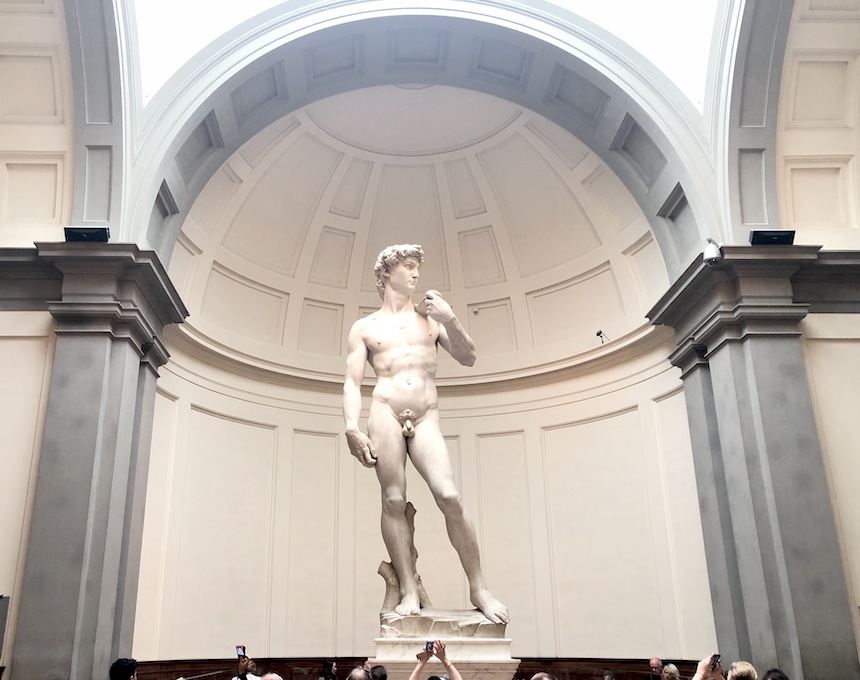
David is likely the most recognizable sculpture in the world by the potentially most recognizable artist in the world, Michelangelo. It is considered a masterpiece of the Renaissance era from 1504. Another artist had supposedly chosen the marble block used to create the statue of David 60 years earlier than Michelangelo, but he decided it was too hard to work with. As the story goes, virtually no one wanted to use this block of marble because they were afraid to break it.
Michelangelo wanted a piece of art to represent Florence, and the republic of Florence as a whole. We learned that David of the Bible is rather a favorite subject and hero in Florence. The Statue of David specifically is a representation of the moments before David faced the giant Goliath.
If you focus on his face, you see that he is concentrating. David is looking left, toward the river. David represents the Republic of Florence or Firenze. Whereas the Medici family, the then enemy of Florence, was across the river where David’s gaze is focused. The Medici’s were even banned to Rome for political reasons, and for the purposes of this sculpture and for Florence, they represented Goliath.
If you’re familiar with the biblical story, you’ll remember that David won with his head and by putting his faith and trust in the Lord rather than in himself. David did not defeat Goliath with strength or physical superiority. Intelligence and Faith will always triumph over the lowest instincts of man like hatred, violence, and everything Goliath represented.
“And David put his hand in his bag, and took thence a stone, and slang it, and smote the Philistine in his forehead, that the stone sunk into his forehead; and he fell upon his face to the earth.”
1 Samuel 17:49 KJV
The movement in David’s body lends more realism to the representation of the body, in both this particular sculpture and all works of art. You can see and almost feel the tension in David’s eyes and face.
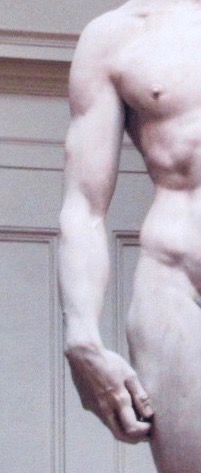
Upon closer examination of his hands, you can see that the right hand is disproportionally larger on the statue of David. This is because the statue was originally supposed to go on the top of the Duomo. Then the church decided that a statue of a naked man may not be the best representation of the church! It was sub-sequently moved to the palace of Florence instead. From further away, the hands look normal in size and proportionate to the rest of the body. This seems to be yet another element of Michelangelo’s genius, who seemingly accomplished what no other sculptor would dare, with a piece of marble that no other sculptor would touch. Isn’t it amazing what our fellow men and women in the human race can accomplish?
JJ specifically asked me “after seeing this statue only in books or photos before today, did you ever think it was that big of a statue in person?” She made a great point and observation. This statue is massive, and about 17 feet tall. It’s one of the most amazing pieces of art we’ve ever seen.
Giambologna or Jean de Boulogne
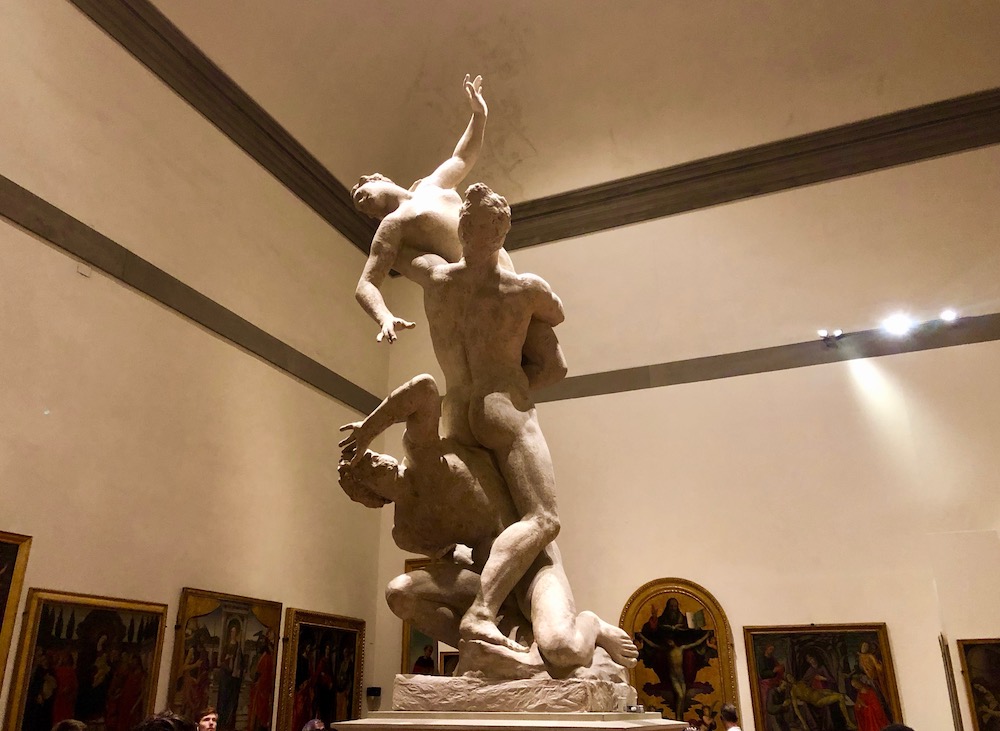
The Rape of the Sabine Women, the indelicately named sculpture by Giambologna (or Jean de Boulogne), was carved out of a single piece of marble. Part of Giambologna’s significance is that he was one of the most famous followers of Michelangelo. He remained in service to the Medici’s for the remainder of his life in Florence.
Nuptial Parade of Adimari Cassone

This decorative artwork is actually a headboard (or decoration from the nuptial chamber) that is believed to have been a wedding gift. It’s significance is that it depicts the history of Florence, and specifically, a wedding taking place in Florence.
El Duomo or The Florence Cathedral
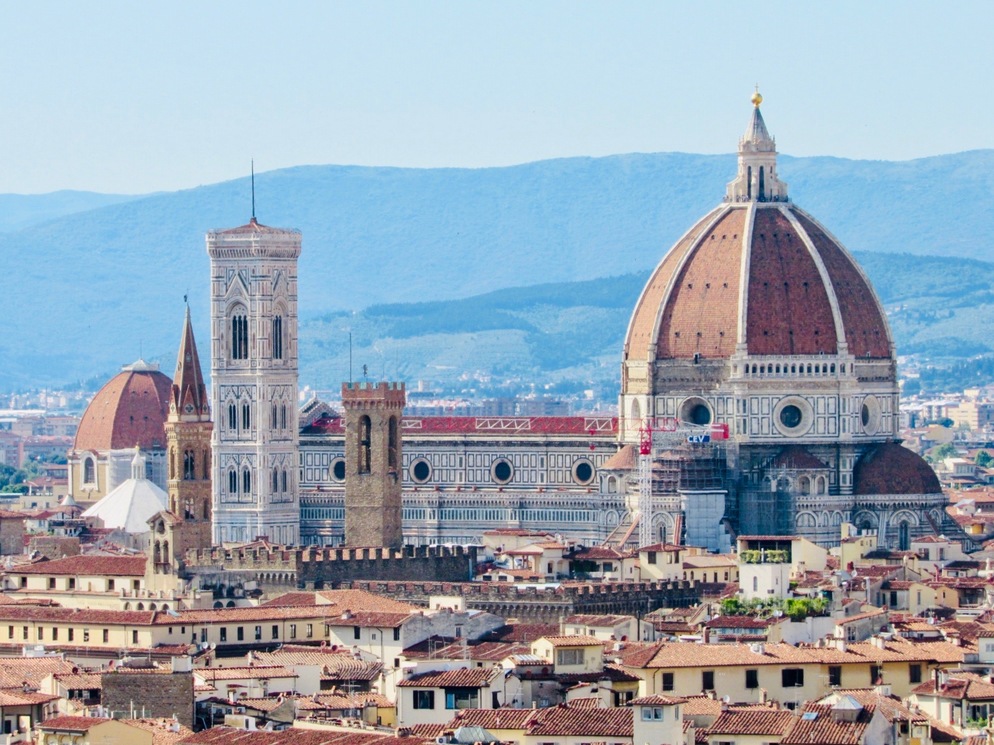
The Florence Cathedral, El Duomo di Firenze in Italian, is simply referred to as “El Duomo” by the locals. El Duomo dominates the skyline of Florence and essentially serves as it’s homing beacon to the city center. It’s one of the first things you’ll notice, and easiest you’ll remember from a trip there. The first thing to point out is that “El Duomo” does not refer to the actual dome of the Cathedral. The dome part is actually called the “cupola”.
Filippo Brunelleschi was the architect and designer who eventually completed the construction of the Florence Cathedral. He was not the original architect, but won a contest to take over the work (after the original designer’s passing) using a brick scale model of the dome made for him by his friend Donatello (the famed sculptor). While the depth of our architectural knowledge is limited, it was explained to us that the design and construction of the Cupola and Dome by Brunelleschi is still somewhat of a modern architectural wonder. He did not leave behind any building plans or blueprints outlining the Dome’s construction. Engineers, Architects, Scientists, and Builders are still trying to figure out exactly how he built this thing with the available technology at hand in 1461.
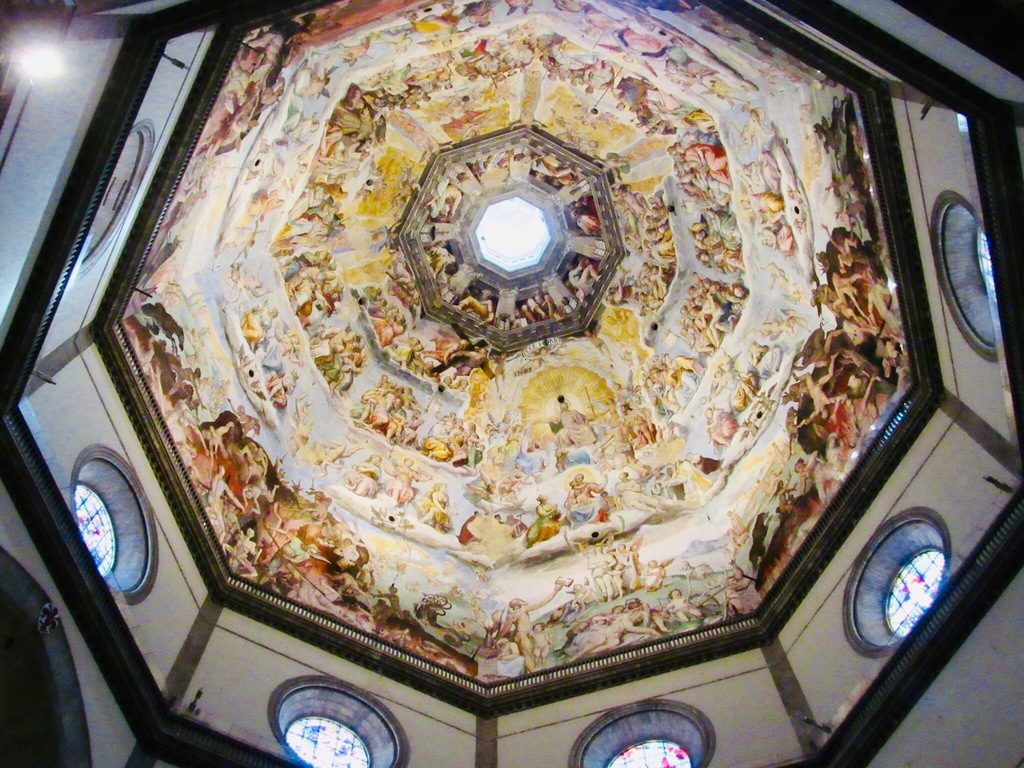
We do know that Brunelleschi constructed two domes, an exterior and interior one. The two domes have approximately two meters empty space between them. This way, both structures were allowed to expand and contract over time. Other famous domes, such as the United States Capital in Washington, would later follow Brunelleschi’s revolutionary design. That’s how forward thinking his design was. It should come then as no surprise, given all the details of this genius revolutionary architect in Brunelleschi, that the exterior of the Cathedral of Florence was actually our favorite part to see.
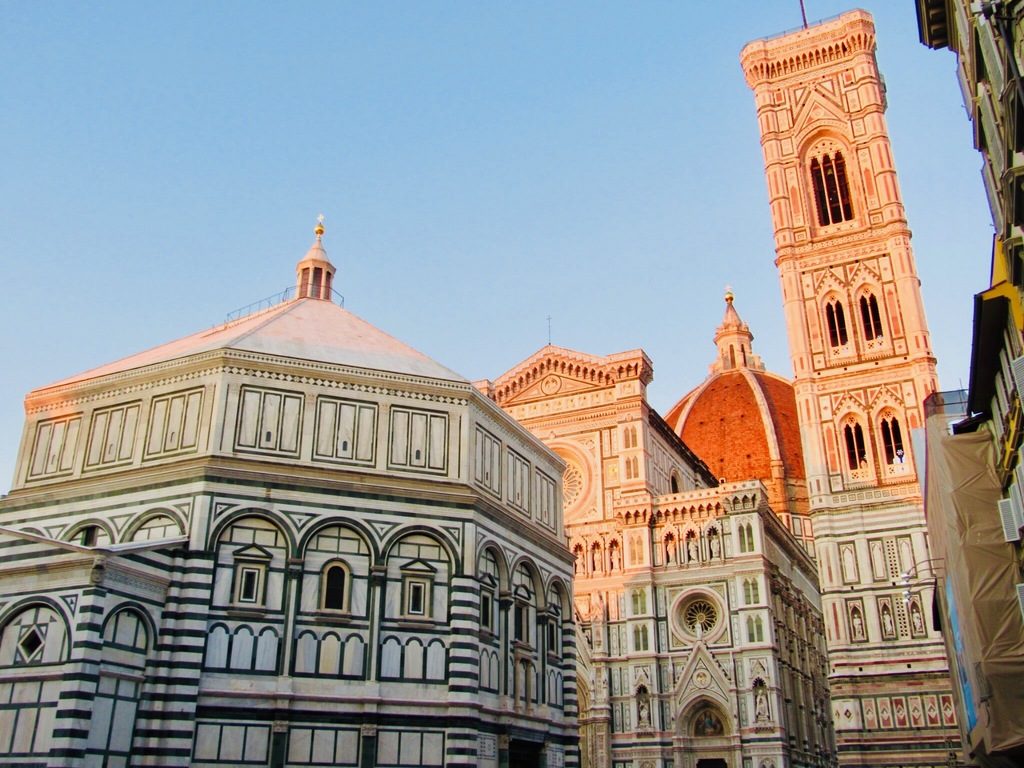
We want to be clear, this is a very touristy destination, both inside and out, and the lines either rival or surpass that of the Galleria di Accademia. We opted to include this on our “Small Group Florence “Skip the Line” David and Accademia with Optional Duomo Visit“ tour. We exercised our option to include the Duomo visit so to speak.
Truthfully speaking, we would not highly recommend visiting El Duomo, or at least paying money to visit the interior. It was honestly one of the most underwhelming and overhyped attractions that we had researched in Florence. If you feel that you must see the inside, we recommend visiting any morning at 8:15 AM for daily mass. This is free if you come appropriately dressed and do not take gawking photos or videos while inside. This is available from the side entrance. Again, just don’t take pictures, be loud, or act like a tourist.
Our main beef with the inside of El Duomo is the fact that you can’t even walk through about half of it as they are trying to preserve the flooring. This was a let down that created an even more crowded experience. Honestly, even our own tour guide did not have much to say about this Cathedral, and spent most of her time inside recommending Galleria di Accademia and the Santa Croce. For our money, the Santa Croce is a much more interesting church to visit that is bafflingly less crowded.
The most impressive part about El Duomo is the architecture and specifically the architect Brunelleschi. His work speaks for itself. But we believe it can be best appreciated from the outside (yes amongst the throng of people) for the price of “free”. In fairness, we cannot speak to the experience of climbing to the top of the Cupola or any of the Bell Towers. There were more hoards of people paying good money and waiting in exorbitant lines to do this. While we’re sure the view at the top is nice, we can’t imagine it being better than that of the Piazzale Michelangelo (where you get amazing views of, yep, you guessed it, El Duomo and the Firenze Cathedral, for the additionally astounding price of “free”).
Santa Croce
The Santa Croce is easily our #2 recommendation of places to visit in Florence behind only the Galleria di Academia. It still seems strange that this understated church (far from the crowds and lines of El Duomo) contains so many significant tombs and works of art from the titans of Italian history.
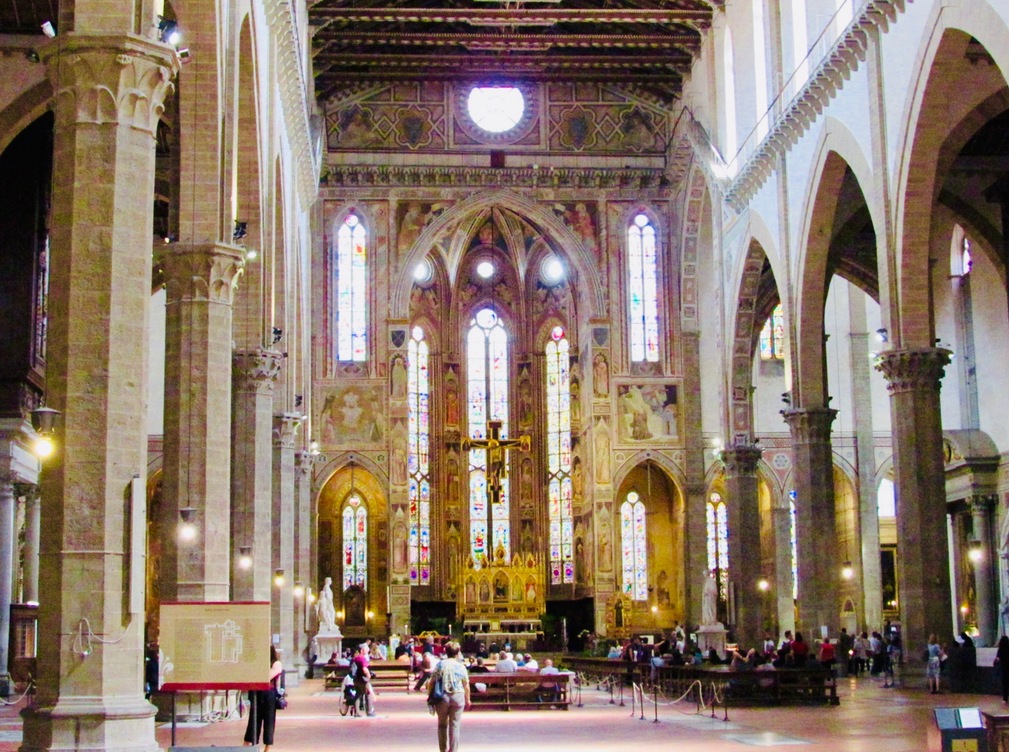
When you consider that the Santa Croce contains the tombs of Michelangelo and Galileo, famed sculptures by Donatello, a plaque honoring Leonardo da Vinci, as well as the massive Last Supper or Ultima Cena by Giorgio Vasari, it’s a head scratcher that this is not actually the top attraction in the city.
One crucial Len and JJ tip is when in Europe, remember to always look “up”. Your eye will naturally be drawn to the famous works of art and tombs of Galileo and Michelangelo all around the walls, but we urge you to not forget to look up at the often highly decorated ceilings!
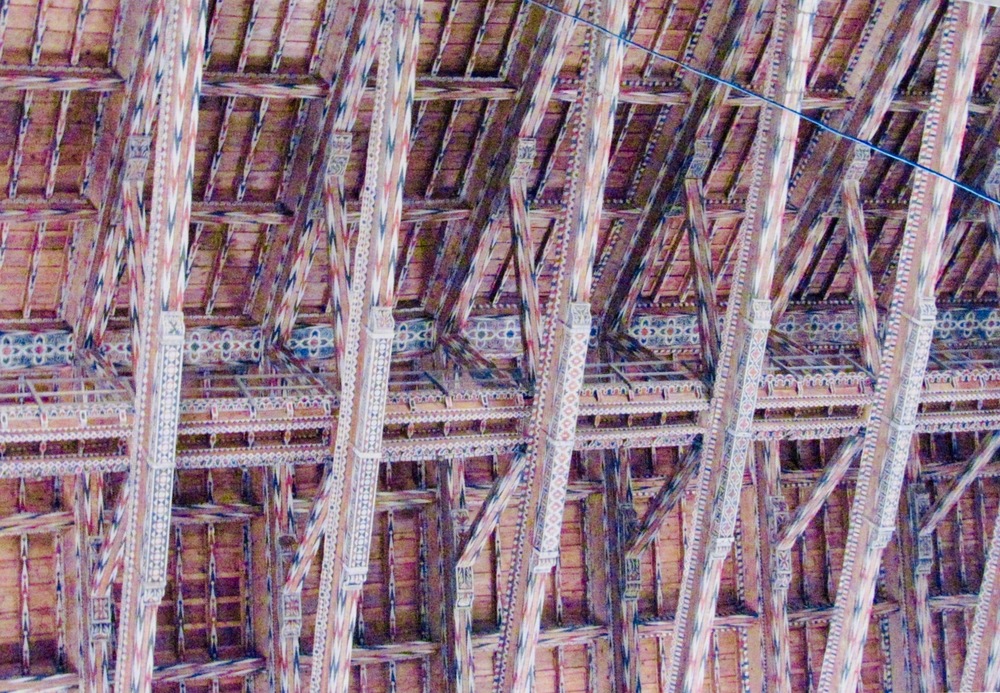
Galileo’s Tomb
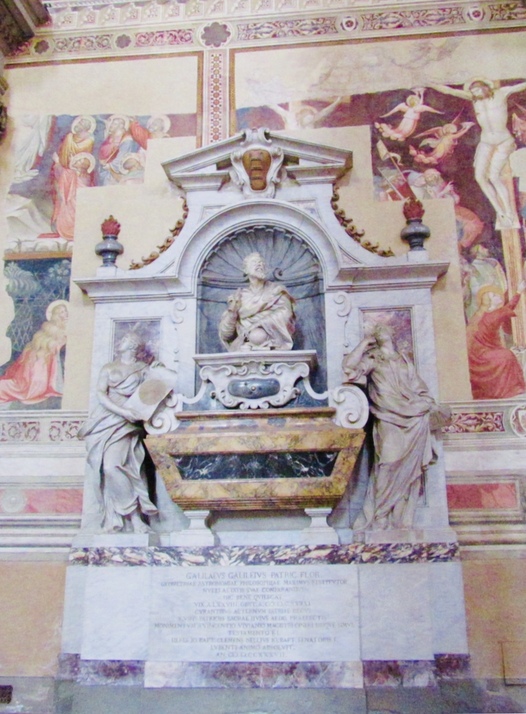
There was originally some controversy over Galileo Galilei being buried in the Santa Croce Basilica. This is mostly due to the famed scientist being under suspicion of heresy by the Catholic Church for his support of heliocentrism (the belief that the earth revolves around the sun and not vice-versa). He was instead, initially buried in a small, out of the way wing of the cathedral grounds. Until 1737, the now visible mausoleum (pictured above) was erected in his honor and his body was reburied in it’s current, more prominent location. There is also the “Museo Galileo” in Florence that we did not visit, although we would absolutely make time for it on a return visit to Florence.
Michelangelo’s Tomb
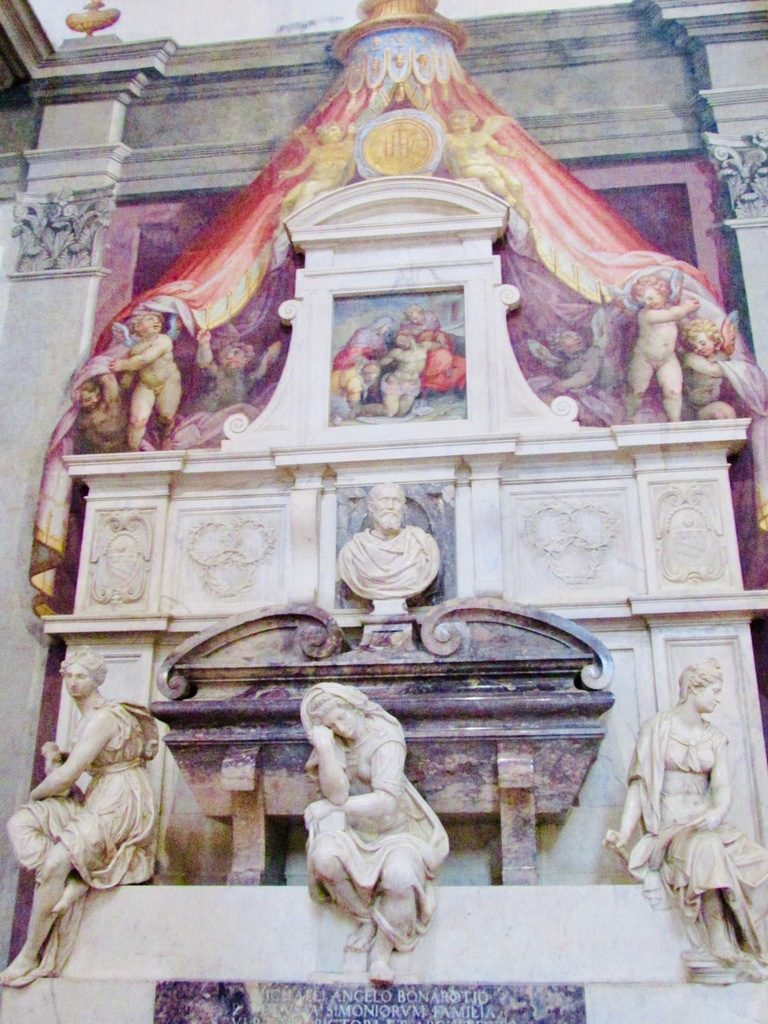
Michelangelo Buonarroti, or Michelangelo di Lodovico Buonarroti Simoni, best known as simply “Michelangelo” is buried here. It was reportedly his last living request to be buried in his home town of Florence.
Donatello – Christ Crucified / Cristo Crocifisso
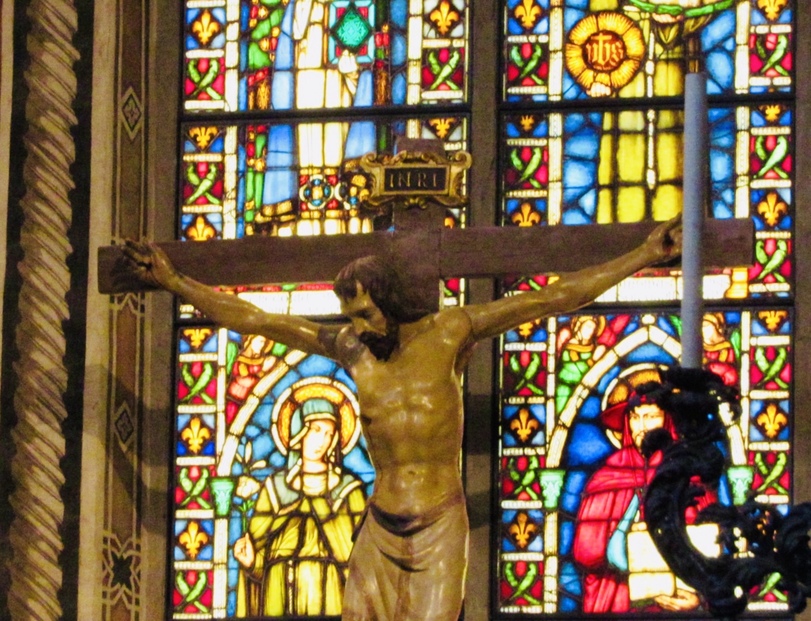
There are actually 3 major works by Donatello in the Santa Croce, including St. Louis of Toulouse, the Annunciation, and Christ Crucified or Cristo Crocifisso. The Crucifix is the rarest and most heavily guarded though. Donatello was apparently close friends with Filippo Brunelleschi, the famed aforementioned architect of El Duomo. These were two extremely talented Florentine Renaissance men. You can read more about Donatello and the contents of of the Santa Croce “straight from the horses mouth” on their own website here.

It’s not every day that you get to see a 700 year old sculpture by Donatello, in the same building where Michelangelo is buried, featuring a commemorative plaque honoring Leonardo da Vinci for good measure. All we are missing is a work by Raphael. 90’s kids can insert their own Teenage Mutant Ninja Turtles reference or nostalgia here. To reiterate, we highly recommend visiting the Santa Croce, even more than El Duomo in Florence.
Last Supper / Ultima Cena
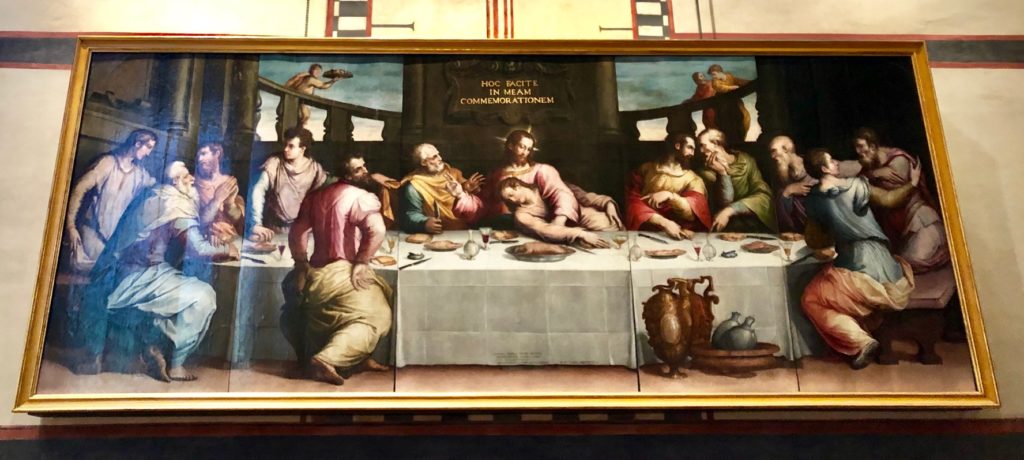
This 1546 work by Giorgio Vasari, “Ultima Cena” was restored after receiving immense damage in the flood of 1966. We admittedly somehow almost missed seeing this magnificent work of art. Surprisingly, it is not located in the main cathedral of Santa Croce, but rather in the Santa Croce Opera House, right outside the cathedral. There is a fascinating video showing the extent of the flood damage, and miraculously, how it was restored thanks to science and painstaking efforts of the City of Florence. A final amazing detail is that it now features a mechanical pulley system, allowing the massive painting to be raised or lowered in the event of future flooding.
Needless to say, I’m glad we didn’t miss the enormous, restored “The Last Supper” painting. Please be aware that this painting is not to be confused with the “Ultima Cena” in Milan of Leonardo da Vinci fame. All the same, this work is not to be missed at the Santa Croce, and deserves just as much of your time and admiration, especially for the restoration process that was undertaken.

Ponte Vecchio
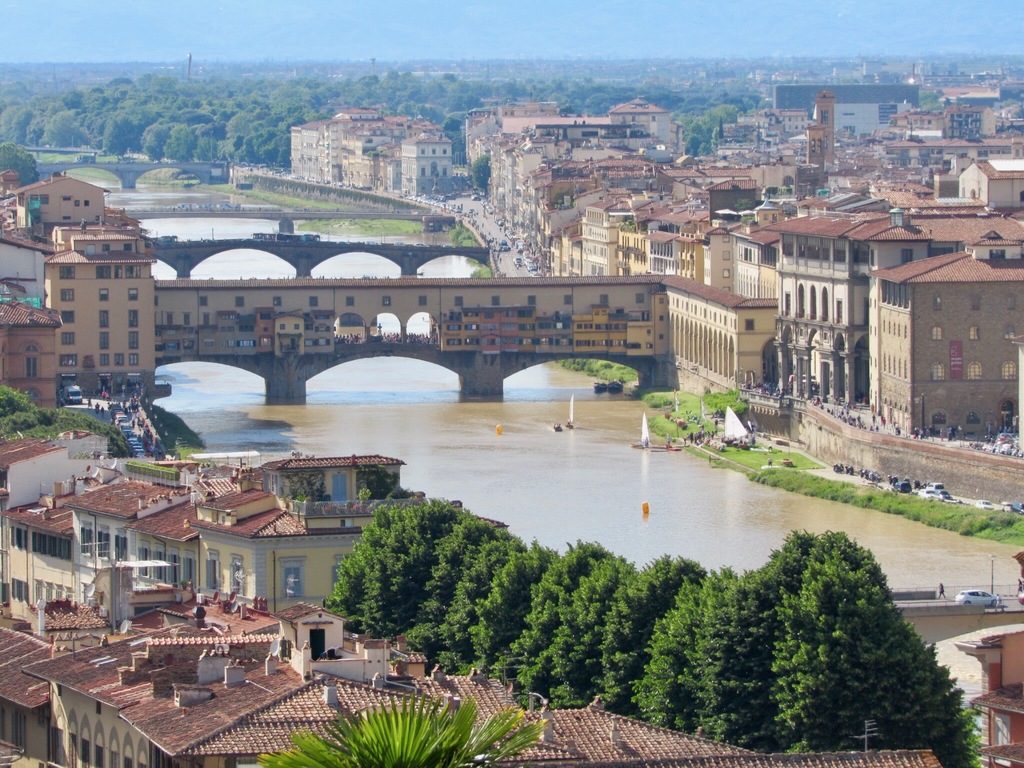
The Ponte Vecchio or Old Bridge was constructed to it’s current state in 1345. During World War II, it was the only bridge in Florence that was not destroyed by the Nazis. It is also home to the Vasari Corridor, which is essentially a secret passage way built and used by the Medici family to connect the Ponte Vecchio with the Palazzo Vecchio or Town Hall. It is uniquely constructed above the bridge and shops, and is clearly visible to this day.
Piazzale Michelangelo
The Piazzale Michelangelo is a pubic square sitting high above the city, that provides panoramic views of Florence. The square also features bronze copies of many of Michelangelo’s famous sculptures, including the Statue of David at the center of the plaza. The Michelangelo Square is reachable by car or on foot, consisting of stairs and steep inclines along the way. There are small kiosks selling refreshments as well as a restaurant with a large terrace. It definitely offers some of the most coveted views of the city, and one of the most sought after selfie opportunities!
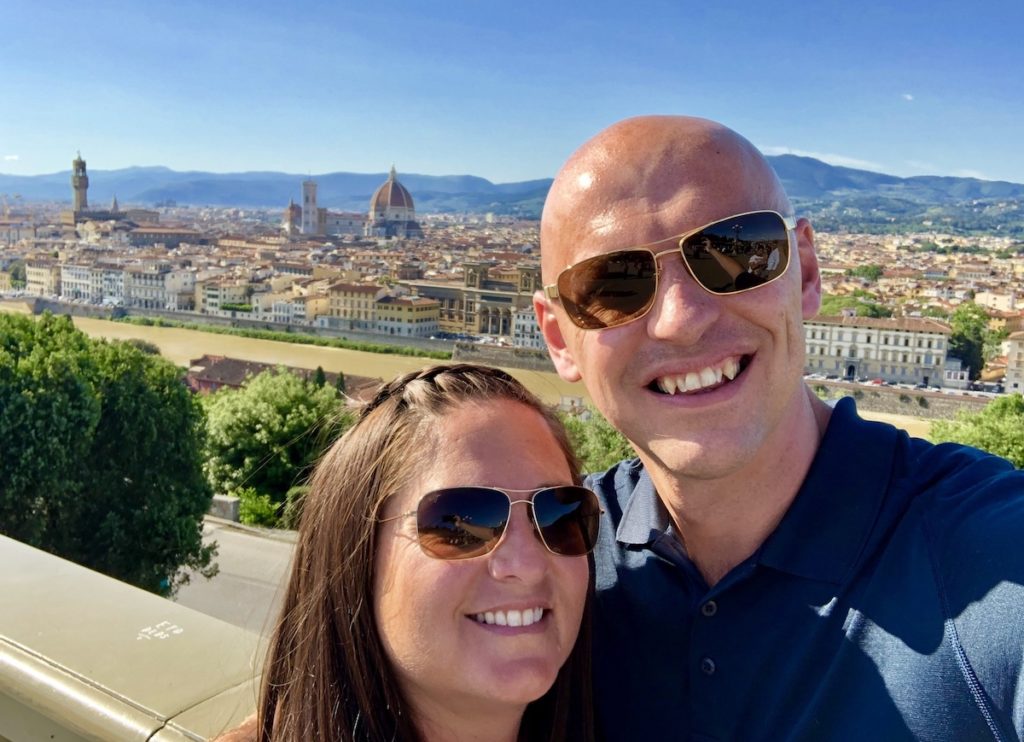
Food in Florence
Gelateria dei Neri

Our Walking Tour guide, Greta, was very passionate about food. She informed us (or at least claimed) that Gelato was actually invented in Florence. It was invented for a celebration by the Medici family. The original flavor was called “Buontalenti”, named after the inventor of this strange new desert from the late 1500’s.
There was only one gelateria, or so we were told, within the city center that still used the original recipe and offered the original Buontalenti flavor, and that was Gelateria dei Neri.
We thought the gelato we had in Annecy, from a place that had been there over 40 years was the best we had ever tasted. We were sorely mistaken. Or rather, we simply hadn’t yet experienced the original gelato that has been around for hundreds of years. Now that we have, any time we passed a touristy ice cream place, or God forbid, someone eating at a frozen yogurt shop in Florence, we could not help but develop a superior smirk on our Buontalenti gelato stained faces. Poor little guys.
Gelateria dei Neri is located on Via dei Neri, which is one of the busiest restaurant streets in Forence. We indeed tried the famed Buontalenti flavor, as one of three flavors mixed together, and it was indeed delicious.
Pizzagnolo
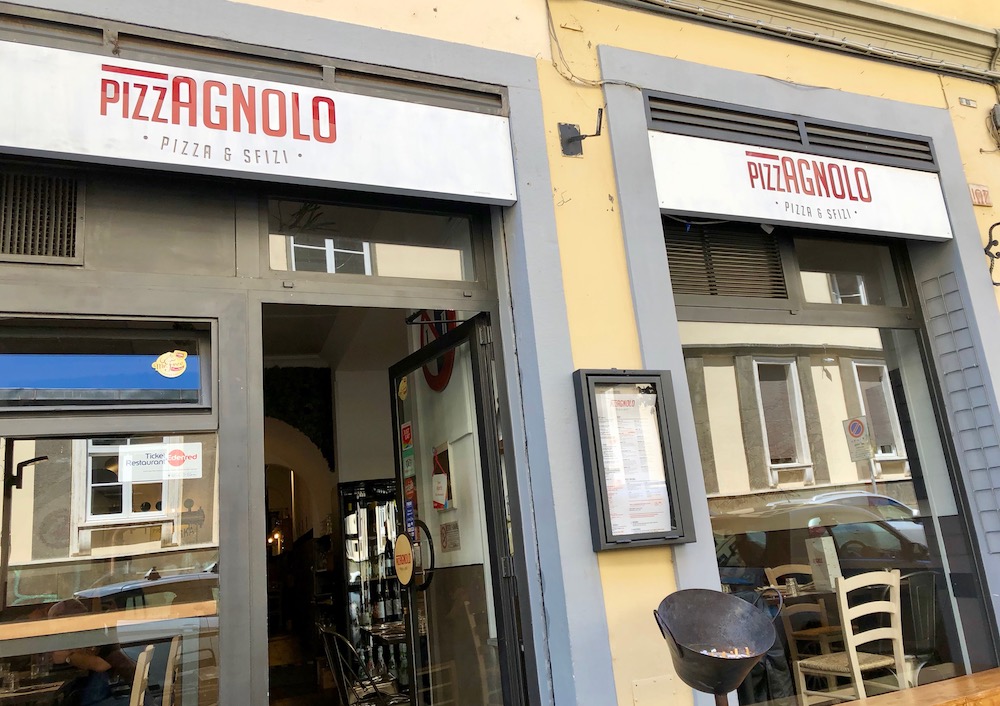
Ask yourself truthfully, how could our first post in Italy, much less Florence, talk about food and not talk about Pizza? Thanks to Pizzagnolo, we aren’t just talking about any pizza. We are talking about the best pizza we had in Florence, and so far, the best pizza we’ve had on our year long trip.
We’re admittedly suckers for authentic Neapolitan style pizza. When you see a giant brick or tiled oven pumping out pizzas so thin and gooey in the middle that the slices have to be folded to be eaten (or God forbid, sacrilegious to any New Yorker, eaten with a fork) you know you’re in for a delicious meal. The secret to any good Neapolitan pizzeria, besides the use of authentic Italian ingredients like San Marzano tomatoes, is how fast they cook their pizza and how little time it spends in the brick oven. They have those ovens so hot that they literally only bake for about 90 seconds to 2 minutes tops.
Hence the majority of the prep time is spent actually constructing the pizza and hand tossing, then rolling out the fresh dough. Such pizzerias, like Pizzagnolo, are the only ones I will ever personally order a Margherita pizza at. That’s tomato sauce and cheese only to those in the know.
Did I mention the meatballs yet? Or the home made hot oil with red pepper at this place? Bad Len… fifty lashes with a wet spaghetti noodle for me. These meatballs were the bomb and the real deal antipasto heroes of our meal. Did I mention they come with some sort of melted, fondue-esque white cheese sauce for dipping?

Traditionally, I’m what’s known as a “sauce guy”. I blame my father, and memories of him mixing Heinz 57, barbecue, ketchup, peanut butter, and virtually any available sauce known to man on the same plate, then dipping something crazy like fish sticks or corn bread in it. Whereas JJ is more of a cheese girl. I kept asking her what voodoo cheesiness made up this mysterious white sauce. She kept shaking her head, borderline ignoring me, and saying “MMM” over and over again. Maybe it was Gorgonzola, who knows. All we know is that it was delicious and that the San Marzano tomato sauce was out of this world. The meatballs also come with bread. Let’s just say that there was no discernible remaining evidence of either the sauce or the cheese when we were through.
The pizza was of course amazing. I recommend getting the meatball app and a pizza with meatballs too just in case your “fear of not getting enough meatballs” sets in after reading this article. This is how pizza in Italy is supposed to taste. What a meal!
La Fettunta

On the same street as Gelateria dei Neri, called Via dei Neri, are a couple of renowned sandwich shops. We noticed that if you get within a few blocks of Via dei Neri, seemingly every other person walking away from that direction is eating a sandwich wrapped in white deli paper with red writing on it.
As we got closer, we saw lines on both sides of Via dei Neri that easily had 100 people each waiting in them. We realized the line was for a place called “All’antico Vinaio”.
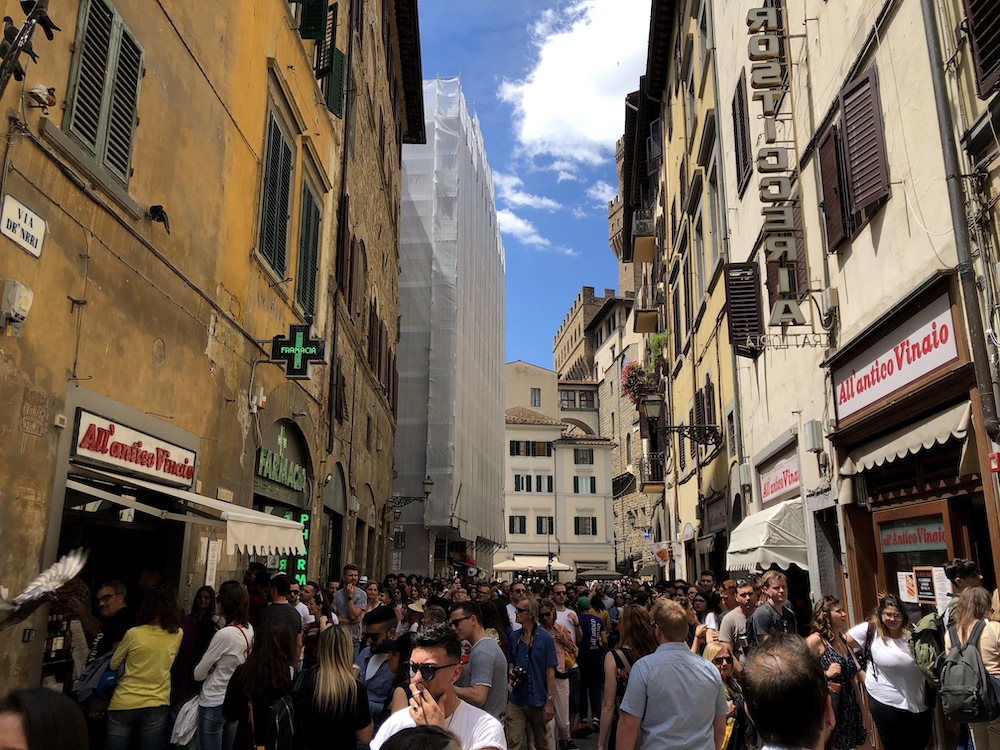
We would love to tell you how unbelievably tasty these sandwiches are, or how worth the wait they were. But it wouldn’t be very Len and JJ-like to wait an hour in line for a sandwich! Instead, we went to the place right next door called La Fettunta. We walked right inside the minuscule space, ordered from the yellow, hand-written menus, and were enjoying our fresh made sandwiches within minutes.
We can’t speak for the other place, but it was the best sandwich we had tasted anywhere in Europe thus far. We later found out that both sandwich shops are evenly deadlocked at an impressive 4.6 Rating on Google! Ha! We couldn’t make this stuff up if we tried.
For those that have been to Philadelphia, and experienced the famed “Pat’s and Geno’s” Philly Cheese Steak rivalry, if La Fettunta isn’t currently considered the “Geno’s” to All’antico Vinaio’s “Pat’s”, we believe they soon will be. Just as soon as people start following their own instincts instead of only following the crowd (or following this blog), that is.
The telltale sign of any good sandwich shop is the lack of pre-made sandwiches in a glass case, that should instead be filled with unsliced meats and fresh ingredients, just itching to be hand-crafted into a culinary delight. It should also smell like freshly baked bread. Unless you find yourself trapped as the victim of a captive audience, such as in a train station or airport, if you see pre-made sandwiches that have been sitting there for God knows how long, run. Run far away. The same goes for pizza and most of the four major travel food groups (sandwiches, pizza, gelato, and we’re still deciding on the fourth, probably kebabs and gyros, thank you very much).
Next time in Florence, we say skip the long line at All’antico Vinaio and give La Fettunta a shot. Their “white” deli paper will just as adequately hold your gourmet sandwich as the “red and white” variety of the competition, and the sandwiches are huge and delicious.
Ristorante Il Paiolo

Ristorante Il Paiolo was close to our Booking.com apartment rental. It was highly rated on both Google Maps and Trip Advisor (a good place to start if you’re hungry, and don’t want to wander around looking at endless menus and restaurant options in a new city). We had an overall good experience at this restaurant, and the pasta was some of the best we had tried.
One thing to be wary of at Ristorante Il Paiolo, and several other restaurants we had seen within the (touristy) city center is the large glass displays of huge dry aged steaks. We’ve done our readers a disservice by not getting a picture of these, but you can see them here on Trip Advisor. As Texans who love our beef, we weren’t about to grossly overpay for steaks in Italy, at an Italian restaurant.
Unfortunately a couple of Aussie table mates weren’t so lucky. They ordered the huge T-Bone, big enough for two people to share, and with a roughly $100 price tag to boot. They “looked” good enough on arrival. But apparently the meat was fatty, tough, and terrible. After sending it back several times to no avail, eventually their meal was comped and ended with an unpleasant exchange and discussion with the restaurant’s manager.
Meanwhile, JJ and I devoured our savory pasta dishes, and had mediocre service at best, largely due to the attention demanded by the poor quality touristy steak fiasco. Then we still got to pay the 3 Euro per person “coperto” or cover charge for the privilege. This was actually our first sit down meal in Florence, and JJ assured me that other places would have the coperto too. She was right of course, but we didn’t exactly enjoy paying for the privilege on this particular evening. Still, we can and do recommend this restaurant for pasta, and recommend that you highly avoid it and places like it for the tourist trap T-Bone steak.
Len and JJ’s Overall Rating:
We Would Definitely Go Back
Even though we’ve hopefully covered a lot on this article that we saw and did, we feel that there is still a lot left to discover in Florence. We believe it to be “one of those cities” like Rome where there is just too much to see and do in one short visit. We didn’t make it to the Uffizi Gallery, Boboli Gardens, or several other museums such as the Galileo. We’re sure there are more pizza, pasta, sandwich, and gelato places to discover as well. We look forward to finding more the next time we return to the whimsical land of Tuscany, and it’s capital of Florence.
Our Site may include some Affiliate Links sprinkled in amongst our completely free, and hopefully helpful content. That means we earn a small commission when you purchase or book something (at no additional cost whatsoever) through our links. It’s like a beautiful “thank you” to Len and JJ and it doesn’t cost you anything! We’ll probably spend it on chocolate or a Thai massage.

